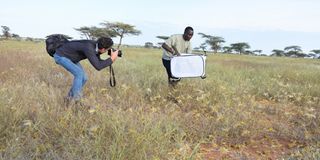Locust invasion in northern, eastern regions threatens food security

Kephis Entomologist Kevin Sambai (right) collects samples of locusts in Lengusaka, Samburu East on January 23, 2020.
Eight counties in Kenya are staring at hunger following a fresh invasion by small mature swarms of desert locusts from neighbouring Somalia that continue to devour vegetation and grasslands.
The ravenous pests that were blown by the strong northerly winds have invaded northern and eastern regions of Mandera, Garissa, Isiolo, Kitui, Tana River and Taita Taveta counties and destroyed crops and grass, threatening food security for residents and livestock.
Coupled with few hopper bands that have started forming in Samburu County — which has been battling infestations throughout the year — the government faces a difficult task of containing the locusts which could start laying eggs any time.
Disaster response teams in Samburu are using special drones equipped with mapping sensors to spray the destructive pests, with the technology proving effective in handling pests in inaccessible remote areas.
Samburu Special Programmes Chief Officer Daniel Leisagor said most of the swarms in the county are almost maturing and could start breeding any time due to the cool environment brought about by the ongoing short rains.
Heading to Tanzania
The swarms in Taita Taveta, the latest to be invaded, were last spotted heading towards north east Tanzania and landed in Kilimanjaro, Manyara and Tanga areas, reducing the threat on vegetation in the county in the coming few days.
In latest forecast, UN’s Food and Agriculture Organisation (Fao) has warned that the risk remains high in northern Kenya where the locusts could lay eggs in sandy areas and that hatching and band formation could start in early December.
“Although some of the swarmlets that arrived in Kenya may have already laid eggs in southern Somalia before their arrival, there remains a risk of further egg laying in the sandy areas of Northeast Kenya where rains have fallen,” Fao said in its report on November 20.
Locusts take 2-3 weeks to hatch after copulation and egg laying and one swarm can eat food enough for 35,000 people in one day according to Fao.
More worrying to farmers and pastoralists is an impending invasion in coming weeks from neighbouring Somalia and Ethiopia, if recent projections by the UN agency is anything to go by, which will further worsen the situation and pose a difficult task to the government which is also battling the Covid-19 pandemic.
Fao noted that a new generation of immature swarms from the two neighbouring countries, where breeding continues and hopper bands have been sighted, will start forming in the course of this week.
Swarm formation is expected to continue throughout December due to widespread hatching and band formation that occurred in the past week in the neighbouring countries where aerial and ground control operations continue.
“Several waves of numerous swarms [are] expected to move south in Somalia and Ethiopia reaching northern Kenya from [the] second week of December,” the agency said.
While control operations have previously been strained due to lack of enough pesticides and logistical challenges, officials in the northern counties fear the latest invasion could ignite resource-based conflicts and result to loss of lives.





